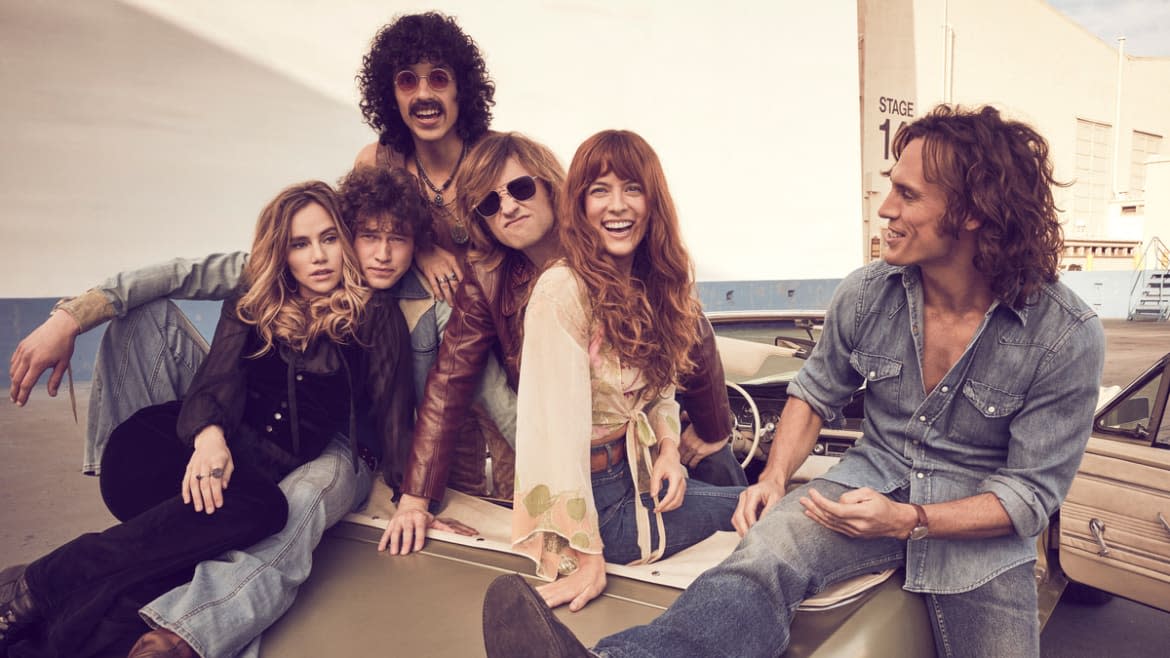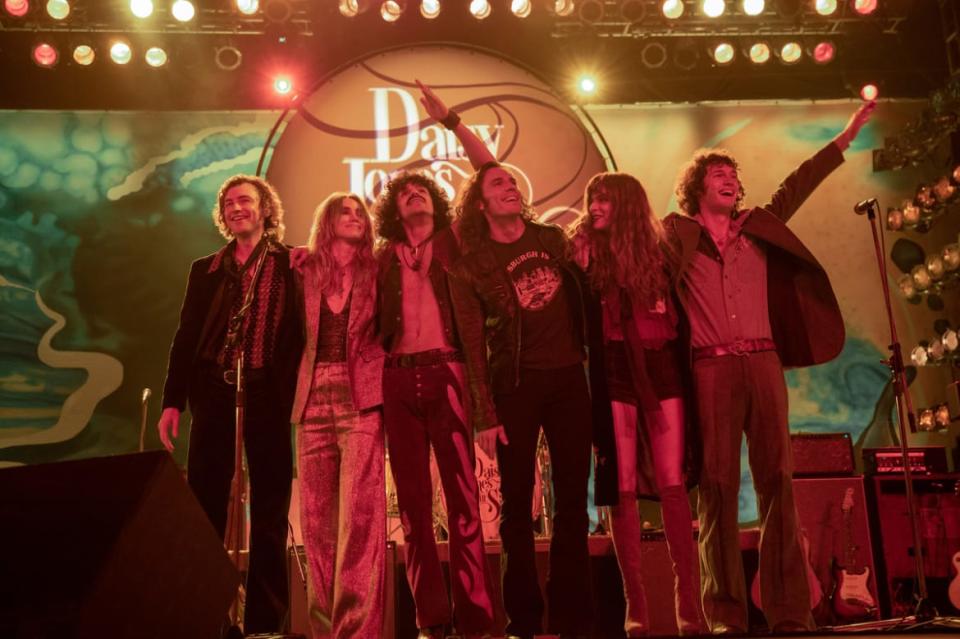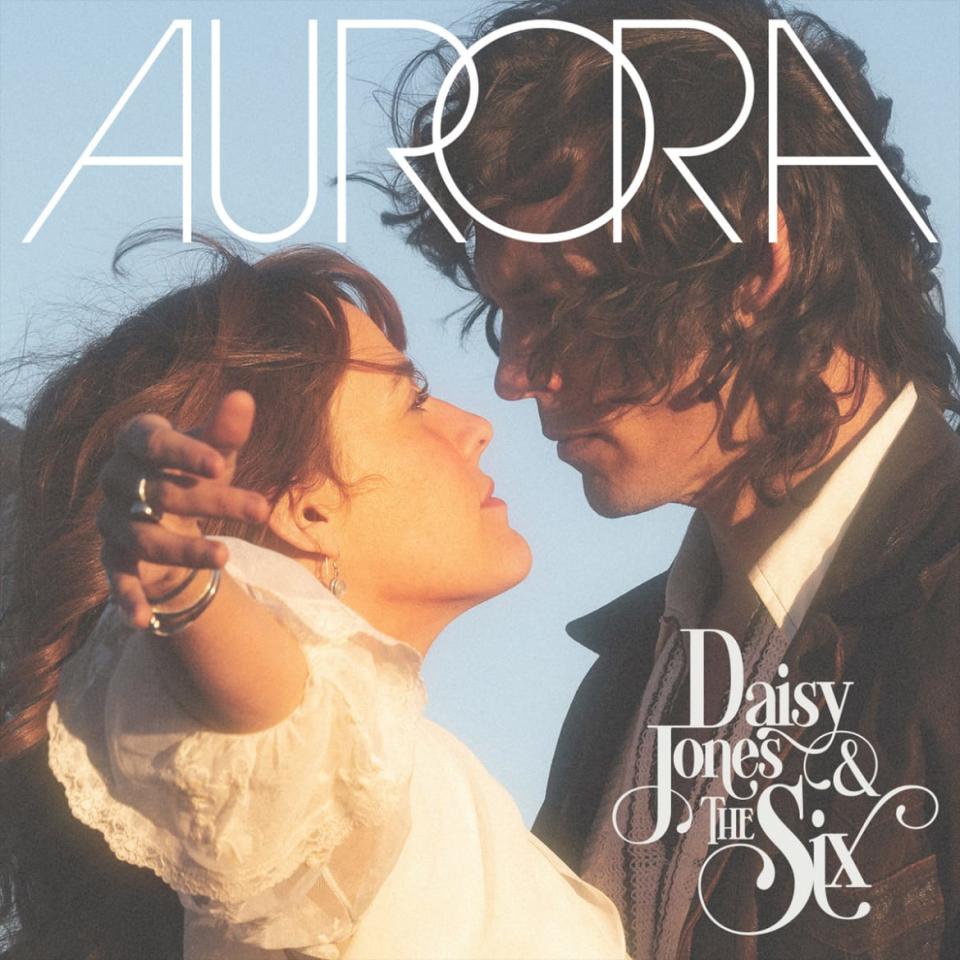Making the Band: How Daisy Jones & the Six Came to Life

- Oops!Something went wrong.Please try again later.
Tony Berg, a music industry veteran with the kind of awe-inspiring, star-packed résumé that could fill a tome, remembers exactly what he thought the first time he met Riley Keough and Sam Claflin, the two leads of Daisy Jones & the Six.
“My first impression was, ‘Uh-oh,’” Berg tells The Daily Beast with a laugh. “Neither of them was a professional singer, and they were going to be asked to perform as singers in what was the biggest band in the world. Now, that is daunting.”
Indeed, the new Prime Video series was tasked not only with bringing Taylor Jenkins Reid’s bestselling 2019 novel to the screen, but also giving life to the fictional, chart-topping ’70s rock band Daisy Jones & the Six. In the book, the band—fronted by Daisy (Keough) and Billy Dunne (Claflin)—rises to superstardom after releasing their 1976 magnum opus, Aurora. Fans of the book have long tried to imagine what songs like “Regret Me” and “Aurora” would sound like, and now, they can actually hear them, as the team behind the series has released a real, physical version of the 11-track album via Atlantic Records.
In crafting the fake-turned-real LP, series co-creator Scott Neustadter says their mission was this: “Create an album as if it was a lost ’70s classic record.” To do that, they enlisted music supervisor Frankie Pine of Nashville fame. Pine then tapped Berg, who served as the series’ chief music consultant and the soundtrack’s co-producer, and his longtime musical partner Blake Mills, who wrote and produced all of the original songs.
Hitting play on Aurora, you get the overwhelming sensation that, damn, this really does sound like a real band and not just a gaggle of hot young Hollywood actors. They sound legit. They sound cool. “Look At Us Now (Honeycomb),” the fictional band’s breakthrough hit, is so good you believe that it could’ve topped the charts once upon a time.
In other words, before you even see them on screen—with all the bell bottoms and porn ’staches and other ’70s period trappings—you buy into the myth of Daisy Jones & the Six’s enormity from their sound alone. A lot has been made of the band’s obvious parallels with Fleetwood Mac—perhaps hinged more on their interpersonal relationships than the music itself. The group’s influence is certainly heard all over Aurora, but not so explicitly that it sounds like a cheap cover band.
“It was important to us that it sounds of the moment in time, but not like a pastiche of a certain kind of group,” Neustadter tells The Daily Beast. “So yes, there are definite Fleetwood Mac vibes all over the place. But we had plenty of Joni Mitchell elements, Bruce Springsteen elements. CCR [Creedence Clearwater Revival] was part of that, and Neil Young was a big one. You can’t ever say, ‘Oh, that sounds exactly like this.’ It just sounds like a song that would have existed at that time.”
‘Daisy Jones & the Six’ Is the Fleetwood Mac Greatest Hits Phenomenon We Crave
Even just the decision to put Mills and Berg at the helm suggests a commitment to making Aurora sound as authentic as possible. These songs were all made at the pair’s home base of Sound City, a legendary L.A. recording studio where Neil Young, Elton John, and, yes, Fleetwood Mac all made albums in the ’70s. Berg says they “had a leg up” in the verisimilitude of it all not just because of their surroundings (though that definitely bolstered the #vibes), but because of the gear that was available to them there. While making Aurora, they used almost exclusively equipment from the ’50s, ’60s, and ’70s, and zeroed in on how musicians used to make records in those days; for instance, using a rhythm section to provide a complete arrangement, instead of relying on the overdubs that became omnipresent beginning in the 1980s.
Mills and Berg also dug into their Rolodexes, calling on frequent collaborators of theirs—including Jackson Browne, Marcus Mumford, Taylor Goldsmith, and Phoebe Bridgers—to co-write songs using different characters’ voices. “It’s not like Blake went to the hit factory,” Berg notes of the producer’s grounded approach to the album. To be sure, these guys are not Top 40 hit-chasers, though the irony is that Daisy Jones is coming at a great time, when much has been made of Gen Z’s fixation on ’70s music and aesthetics.
“The first criteria is, are you writing a great song? If the song is great, it speaks. It captures an audience,” Berg says. “This generation is unique in that they are as well-versed in music from the ’50s, ’60s, ’70s, ’80s, ’90s, aughts, and teens as they are this decade’s music. Today, nothing’s off limits. Everything is part of the canon. But the mandate always has been and always must be for songwriting—intelligent lyrics, melodic twists, harmonic knowledge, artful record-making. These things have timelessness.”
Assembling the Six
After about a year and a half, Mills and Berg had all the music written and refined, including the songs for Aurora as well as the dozen or so other original tracks created for the show—among them, the early proto-disco jams sung by Daisy’s best friend Simone (Nabiyah Be) and the punk and psychedelic rock cuts performed by other fictional bands along the Sunset Strip.
With Daisy Jones & the Six, however, it’s not enough for the songs to be great—they have to be sold by the right performers. To that end, it was vital that the actors who were cast had at least some musical experience, though that rule was sometimes applied loosely.

Will Harrison, who plays lead guitarist Graham Dunne, had been in a band in college. Sebastian Chacon, who had done some drumming, was cast as the ultra-chill drummer Warren Rojas. Josh Whitehouse, who nabbed the role of bassist Eddie Roundtree, mercifully already knew how to play guitar. And model/actress Suki Waterhouse, who plays badass keyboardist Karen Sirko, is also a rising indie-pop artist who released her debut album last year.
The only sure bet, in the producers’ eyes, was 33-year-old Keough—despite the fact that she’d never sung or played guitar before.
“Riley was the ‘for sure,’” music supervisor Pine says. “I’m not really sure [why], besides the fact that she wanted the role. She read for them and they said, this is our Daisy. And then they looked to me to be like, all right, you’re gonna make this happen for us. Make sure she can sing and make sure she can play guitar.”
In Reid’s book, Daisy is introduced to readers as a magnetic, wild-child firecracker; she’s commanding and sexy and the first one to brand herself a superstar. When we meet Daisy in the show, however, she’s more timid; an aspiring singer-songwriter with mommy issues and a feathery falsetto, who comes alive once she joins the band and unearths her confidence the hard way (looking at you, Daisy’s no-good ex who stole her “Stumbled on Sublime” song!). Keough, whom Neustadter describes as reserved and quiet, went through a similar sort of evolution while assuming the role.

“Riley had never sung. She had no idea what she was going to sound like,” Berg recalls. “So for the first couple of months, anytime she’d hear her own voice, she’d just leave the room. It was difficult for her. What she didn’t realize is, she has a great natural tone and she can belt without it being corny.”
But the ballad of Daisy Jones is nothing without her foil Billy Dunne—and that turned out to be the hardest role to cast. Neustadter recalls that Claflin had “very little musical experience” and wasn’t helped much by a cringey audition in which he sang Elton John’s very un-Billy-like ballad “Your Song.”
“It was so antithetical to anything that we were doing, but he was like, ‘Oh, ’70s rock song, I’ll do that!’ They were all shaking their heads,” Neustadter remembers. But after they gave Claflin a Beatles song to learn and he came back a second time, “They went from, like, ‘DEFCON 5, you can’t with this guy,’ to, ‘OK, there’s some potential here.’ … Once Tony told us that he could sing, and his [chemistry] read with Riley was amazing—there was an interesting back and forth between the two of them, and their body language was always really cool—we just started to see it.”
Indeed, the entire story of Daisy Jones & the Six hinges on Billy and Daisy’s will-they-or-won’t-they romantic relationship, as well as their stormy but extraordinary musical connection. Some of the show’s most thrilling scenes are the ones where the two of them are writing songs together; you see them unleash a fiery competitiveness while also drawing out the best in each other. She gets off on discovering his vulnerabilities, and he relentlessly pushes her to be better, to sing harder.
“They would find that interaction,” Berg says. “And that chemistry is also fought with an anti-chemistry, as it is in bands. Go look at [the Beatles documentary Get Back]. Watch how George and Paul interact. It’s great and terrible. And every band experiences the same thing. So what I think they did very convincingly was show us what it is to be in love with something and frustrated by that same thing. … The intrigues and the enmities and the jealousies that are in every band—it’s part of the engine. It’s part of what makes bands click, even though it’s ultimately the thing that breaks them up.”
You see in the show how that fraught chemistry inspires some of the Six’s best songs (namely the ones where Keough and Claflin are trading vocals back and forth across an emotional battlefield, almost like they’re sparring through thinly coded lyrical messages to one another). Without it, you don’t get songs like “Kill You to Try,” “Regret Me,” or “More Fun to Miss”—all ones that, as Berg describes, have the kind of intensity that “required the two of them as singers to let go and jump off the cliff.”
‘Holy Shit, They're a Band’
The Six’s chemistry was also fortified during what Pine and her crew lovingly called “band camp,” which is exactly what it sounds like: a months-long crash course in how to be a rockstar.
Beginning in January 2020, three months before they were due to begin filming, the cast would get to Sound City at 8 am, take one-on-one music lessons, play together in a rehearsal space, and then just hang out and shoot the shit, as real bands spend most of their time doing. They also studied footage of rock stars, including one of Chrissie Hynde recording a Pretenders album and performance clips of Janis Joplin and Bruce Springsteen. (For the record, no, Neustadter says they didn’t show the cast any clips of Keough’s grandfather, Elvis Presley.)
Then, COVID-19 struck, production got delayed, and everyone was sent home for a year and a half—a hurdle that ultimately proved beneficial, as it gave the cast extra time to learn their instruments from home and over Zoom. By the time they reconvened 18 months later, Neustadter says, “they went from Bs to A-pluses in just a shocking way.”
You can see the results on screen—the actors got so good that they’re playing drums and guitars with cigarettes hanging out of their mouths, looking effortlessly nimble. Keough is a bewitching frontwoman, channeling Stevie Nicks and Florence Welch on stage, while Claflin transforms into a brooding rock god who rivals Almost Famous’s Russell Hammond in sheer coolness. Pine admits she “was in tears” the first time they shot the full band performing together on set: “Riley lit up. Sam lit up. Everybody really lit up in that moment, and it was, ‘Holy shit, they’re a band.’”
How Indie Supergroup The Arcs Caught Lightning in a Bottle—Again
And, just like a real band, Daisy Jones & the Six are irrevocably flawed—we know from the very first episode that they don’t stay together long, which is perhaps what makes Aurora such a thrill to listen to. It’s a lightning-in-a-bottle moment that captures a band in their golden hour, albeit a totally made-up band.
“There’s a moment where Riley sings a song called ‘It Was Always You.’ That’s the stuff you can’t manufacture,” Berg says. “You have to have a great song, you have to have a performance that moves you, and both things happened here. And it’s not perfect. It’s raw and it’s wonderful. TV rarely exposes you to that; it’s more prone to sanitizing and idealizing. This show attempted to show the warts.”
Keep obsessing! Sign up for the Daily Beast’s Obsessed newsletter and follow us on Facebook, Twitter, Instagram and TikTok.
Get the Daily Beast's biggest scoops and scandals delivered right to your inbox. Sign up now.
Stay informed and gain unlimited access to the Daily Beast's unmatched reporting. Subscribe now.

